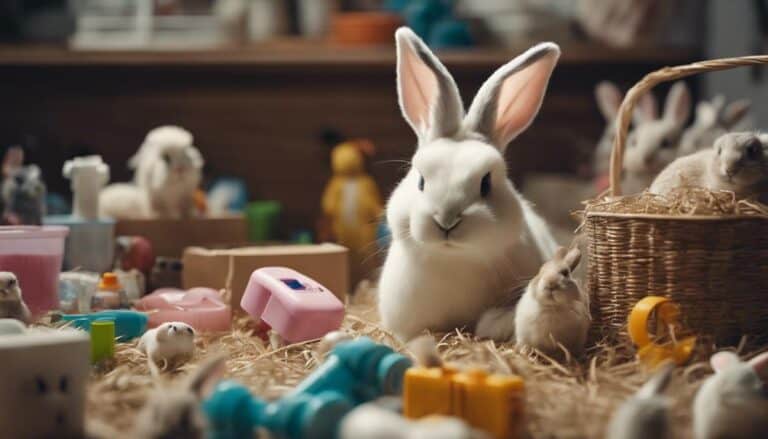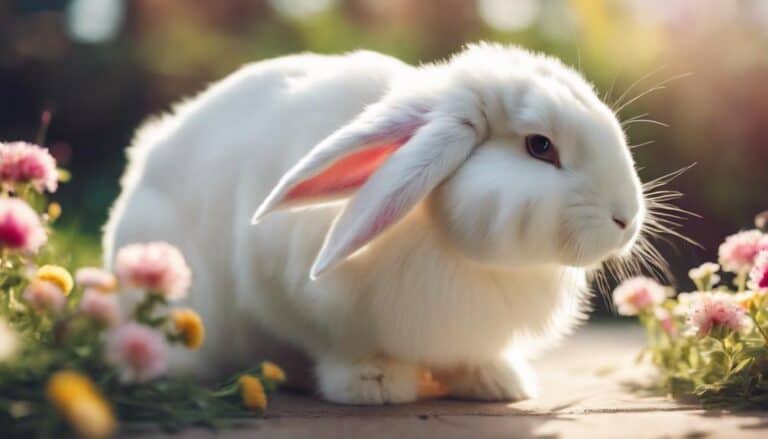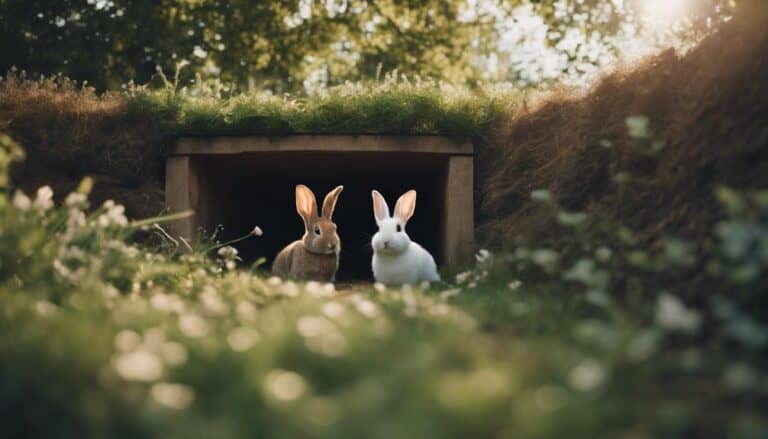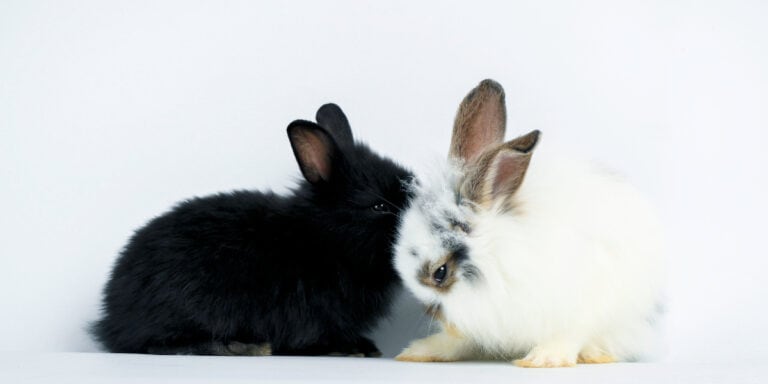When you're thinking about what to do with your pet rabbit, you need to consider a lot of things to make sure they're happy and healthy.
First, you need to find the right person to take care of them. This is super important because rabbits need a lot of attention and care.
Next, you need to make sure they have a fun and interesting place to live. Rabbits can get bored just like humans do, so you need to provide them with toys and things to do.
Finally, you need to give them the right food. Rabbits have special dietary needs, so you need to make sure you're giving them the right kind of food to keep them healthy.
By doing these things, you can create a great bond with your rabbit and make sure they live a happy and healthy life.
Contents
Key Takeaways
So, you're wondering what to do with your pet rabbit? Well, first of all, it's essential to provide a balanced diet. This means giving them fresh veggies, hay, and limited fruits.
In addition to a healthy diet, your rabbit needs mental stimulation. You can achieve this by providing toys, play sessions, and safe exploration opportunities. This will keep them engaged and active.
When it comes to their living space, make sure you create a safe environment. This means a spacious hutch, solid flooring, and good ventilation. Your rabbit will appreciate the room to move around and breathe easily.
It's also crucial to handle and socialize your rabbit gently. This will help build trust and companionship between you and your pet. Remember to be patient and gentle when interacting with them.
Lastly, ensure your rabbit has unlimited access to hay. This is vital for their optimal digestion and overall well-being.
Choosing the Right Caregiver

When you're away, your pet rabbit needs someone to care for them who understands how important it's to stick to a regular feeding schedule and provide consistent amounts of hay. Rabbits have specific needs, and any changes to their routine can lead to health problems.
The caregiver you choose needs to be knowledgeable about these needs and be able to follow instructions carefully. They should also be able to notice any changes in your rabbit's behavior and make sure they're comfortable and happy while you're away.
To make sure your rabbit gets the care they need, leave detailed instructions for the caregiver. This should include information about feeding times, how much hay they need each day, and any special requirements they may have.
It's also a good idea to leave emergency contact information in case the caregiver has any questions or concerns.
Providing Enrichment Activities
Providing enrichment activities for your pet rabbit is pretty important to incorporate into your bunny's daily routine.
Toys are a great way to provide mental stimulation. You can rotate them regularly to keep things interesting for your rabbit. Interactive play sessions are also a lot of fun for your bunny. You can try hiding treats or toys around their enclosure to encourage them to search and problem-solve.
Providing safe exploration opportunities is also crucial. Rabbits are curious creatures, and they love to explore new environments and objects. Just make sure to supervise them during these activities to ensure their safety.
These enrichment activities are essential for keeping your bunny happy and healthy. They prevent boredom, promote physical exercise, and support mental well-being.
Toys for Mental Stimulation
So, you want to keep your pet rabbit's mind active and engaged?
One way to do this is by providing a variety of stimulating toys and objects in their environment. Rabbits have a natural instinct to chew, so offering safe chew toys like cardboard rolls or untreated wicker baskets can keep them occupied and mentally stimulated.
The key is to mix things up regularly. Rotate these toys every 3-4 days to maintain your rabbit's interest and prevent them from getting too familiar with the same old things.
Another way to engage your rabbit's mind is by hiding hay or treats inside toys or objects. This encourages foraging behavior, which is mentally stimulating and mimics their natural behaviors in the wild.
You can also create a 'treasure hunt' by hiding treats or toys around their enclosure, offering entertainment and a fun challenge for your rabbit.
Interactive Play Sessions
To keep your pet rabbit's mind engaged and provide some extra mental stimulation, try incorporating interactive play sessions into their daily routine. These sessions are great because they not only get your pet rabbit moving but also challenge their minds, which leads to a happier and healthier bunny.
One key thing to remember is to rotate the toys you use during playtime. Introduce a variety of toys to keep things interesting and prevent boredom. For example, you could use tunnels, balls, or puzzle feeders that provide mental challenges while encouraging physical activity.
Interactive play sessions are also a great way to bond with your pet rabbit. Use this time to spend quality time together, whether it's gentle petting, clicker training, or even teaching simple tricks like hopping over small obstacles. This will help strengthen your relationship and create a deeper connection.
Before you start, make sure the play area is safe and rabbit-proofed. Check for any hazards and supervise your pet rabbit during playtime to ensure they're safe and can explore freely without any risks.
Safe Exploration Opportunities
Rabbits need mental and physical stimulation to stay healthy and happy. One way to provide this is by incorporating enriching activities into their daily routine.
Supervised roaming is a great way to give your rabbit a chance to explore safely. Take your rabbit out of its enclosure and let it roam around the house under your watchful eye. This will give it a chance to exercise and have some fun.
Chew toys are also a must-have. Rabbits love to chew, and if you don't provide them with something to chew on, they might turn to your furniture instead. Cardboard is a great option – it's cheap, easy to find, and will keep your rabbit's teeth healthy.
Rabbit tunnels and hiding places are another great way to encourage natural behaviors. Rabbits love to forage, seek, and hide, so providing them with tunnels and hiding places will keep them mentally stimulated and exercised.
You can also hide hay in objects or use foraging toys to stimulate your rabbit's foraging instinct and problem-solving skills. This will keep them busy and engaged, and will also help to reduce boredom and stress.
If you're worried about your rabbit digging up your backyard, consider creating a digging sandbox indoors. This will give your rabbit a safe and mess-free space to engage in its natural digging behavior.
Ensuring Proper Diet and Nutrition
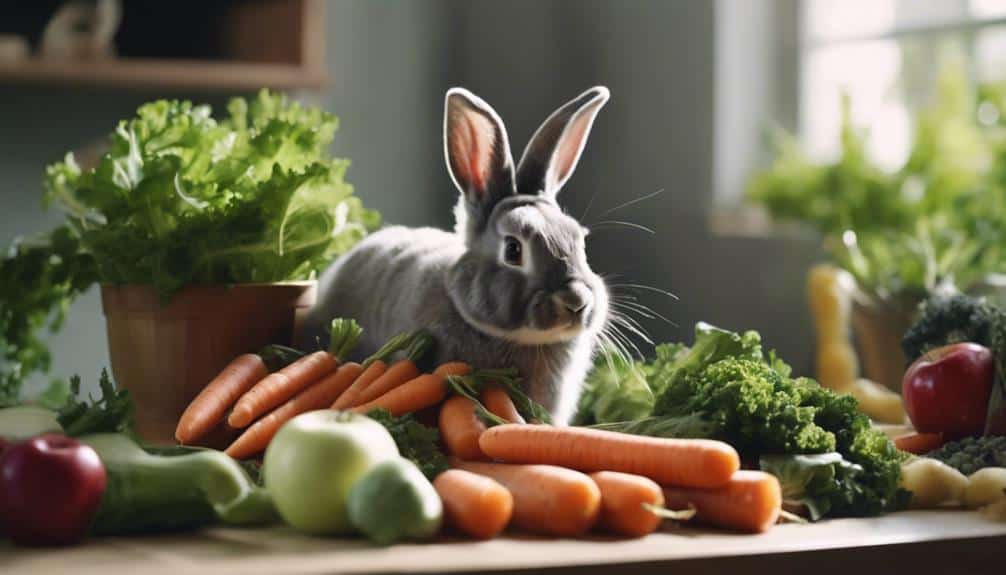
A balanced diet is crucial for your rabbit's overall well-being.
Fresh food choices, like green vegetables and hay, are super important for their digestion and provide essential nutrients.
The key to preventing health issues and keeping your rabbit happy is a high-fiber diet with the right mix of foods.
Balanced Rabbit Diet
Maintaining a balanced diet is crucial for your pet rabbit's health and happiness. So, what does this diet look like?
First, your rabbit needs a high-fiber diet. Grass hay should be the main staple of their daily diet. This promotes digestive health and helps them maintain a healthy weight.
It's essential to give them unlimited access to grass hay and/or grass for their overall well-being.
In addition to hay, fresh greens are a must. Add about 2 cups of fresh veggies to their daily meals to provide essential nutrients and minerals.
This helps support their overall health and energy levels.
Now, about commercial rabbit pellets. These should only make up about 10% of their diet.
Opt for pellets specifically formulated for rabbits to ensure they get the necessary nutrients without risking obesity or other health issues.
Fresh Food Choices
As a herbivore, your rabbit needs a diet rich in fiber to stay healthy. One way to do this is by giving them fresh veggies like leafy greens, carrots, and bell peppers. They should get about 2 cups of these veggies every day. Just remember to introduce new veggies slowly so you don't upset their stomach.
In addition to veggies, your rabbit needs unlimited amounts of fresh hay, like timothy or oat hay. This helps keep their teeth healthy and their digestive system running smoothly.
Fresh fruits like berries, apples, and bananas are also okay in moderation – about 1-2 tablespoons per pound of body weight each day. Just be careful not to give them too much, or they might get fat or sick.
Make sure to avoid giving them foods high in sugar, salt, or fat, like avocado, onions, or chocolate, because they can be bad for your rabbit's health.
It's also important to remember that some veggies, like spinach and beet greens, are bad for rabbits because they're high in oxalates. So, make sure to choose veggies that are safe for your pet.
And don't forget, fresh foods should only make up about 10% of your rabbit's total diet.
Hay for Digestion
So, you want to make sure your pet rabbit is eating right and staying healthy. The key to this is making sure they're getting enough hay for digestion. Grass hay is super important for your rabbit's digestive system, and it helps keep them healthy and running smoothly.
There are three main reasons why hay is essential for your rabbit's well-being. Firstly, hay is high in fiber, which makes up at least 80% of your rabbit's daily diet. This high fiber content helps with digestion and prevents problems in the gut.
Secondly, hay is packed with nutrients like vitamins, minerals, and proteins that your rabbit needs to stay healthy. It helps them maintain a healthy weight and supports their immune system.
Lastly, a diet rich in hay can help prevent common health problems in rabbits, like obesity and dental issues. By making sure your rabbit always has access to hay, you're promoting their overall health and helping them live a long and happy life.
Setting Up a Safe Environment
When setting up a safe environment for your pet rabbit, it's crucial to provide a hutch that meets specific requirements to ensure their well-being and comfort. Your rabbit's hutch should be a sanctuary, protecting them from predators and harsh weather conditions.
The size of the hutch matters. It should be at least three hops long and twice as wide as the rabbit. This will give them ample space to move around comfortably.
The flooring is also important. You'll want to opt for solid flooring to prevent foot injuries. Wire floors are a no-go, as they can be harmful to your rabbit's feet.
The material of the hutch is a significant factor. Wooden hutches are a better choice than metal ones, as they won't overheat and make your rabbit uncomfortable.
Good ventilation is vital to keep the hutch fresh and healthy for your rabbit. Make sure there's good airflow to prevent the buildup of ammonia from their waste.
Temperature regulation is also crucial. You can use frozen drink bottles to cool the area, and keep the hutch shaded to prevent overheating.
Handling and Socializing Your Rabbit
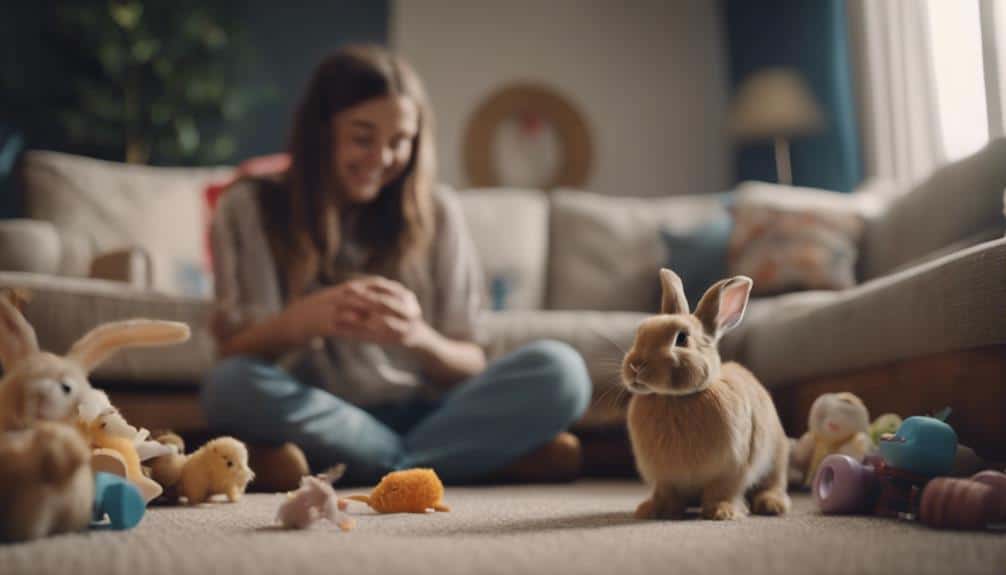
Handling and socializing your rabbit is crucial for their well-being. Rabbits are social creatures that thrive on companionship, so it's essential to build trust and create a positive bonding experience.
When you first start, approach your rabbit calmly and gently. Let them get comfortable with your presence before trying to handle them. Spend some time near their living space, talk softly, and offer treats to establish trust. This slow approach will help your rabbit feel more at ease around you.
When you're ready to pick up your rabbit, make sure to use the proper technique. Support their hindquarters and hold them securely against your body. This helps reduce the risk of injury and makes your rabbit feel safe.
It's also important to observe your rabbit's behavior while handling them. If they start thumping their hind legs or try to escape, it's a sign of stress. By paying attention to these cues, you can create a positive and healthy bond with your rabbit.
Being Aware of Health Concerns
Rabbits can be prone to various health issues, like dental problems, breathing difficulties, and tummy troubles.
To avoid these problems, it's crucial to prioritize preventative care. This means taking your rabbit to the vet regularly for check-ups, vaccinations, and parasite control.
Also, be mindful of heat stress, which can be really harmful to rabbits if the temperature goes above 28C. If you suspect heat stress, get your rabbit to the vet right away.
Grooming is another essential part of keeping your rabbit healthy. It helps maintain their coat and overall well-being.
Create a safe space for your rabbit by supervising them and making sure the area is rabbit-proofed to avoid any household hazards.
Conclusion
So, you want to make sure your pet rabbit is happy and healthy.
The most important thing is to give them a loving and stimulating environment. This means providing a clean and spacious living area, plenty of toys and hiding places, and lots of opportunities for exercise and play.
A balanced diet is also crucial. Rabbits need a high-fiber diet rich in hay, grass, and vegetables, with limited amounts of pellets and fresh fruits. Make sure they always have access to fresh water too.
Regular vet check-ups are essential to catch any health issues early on. Your vet can also give you personalized advice on caring for your rabbit.
When handling your rabbit, be gentle and respectful of their boundaries. Rabbits are prey animals and can be easily stressed, so move slowly and carefully around them.
By being attentive to your rabbit's needs and behavior, you can guarantee a happy and healthy life for them. Remember, your rabbit relies on you for their care and happiness, so be a responsible and compassionate caregiver.



